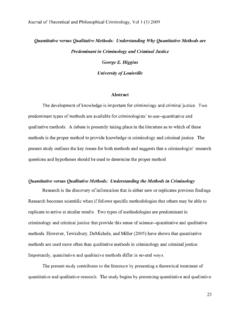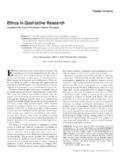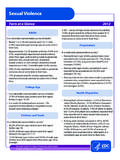Transcription of Applied Evidence-Based Policing Practices: …
1 VCPI TCPHS. COPS Training Support Package Instructor Manual Applied Evidence-Based Policing practices : homicide Violent Crime Reduction Course Design Document ILT. Virginia Center for Policing Innovation (VCPI). [11-11] Administrative Module Page A- 1. Applied Evidence-Based Policing practices : homicide and Violent Crime Reduction (HVR) COPS Office ILT Document Applied Evidence-Based Policing practices : homicide and Violent Crime Reduction (HVR). Curriculum Matrix Overview Over the past two decades, overall violent crime has been steadily declining. Yet the impact of homicide and violent crime remains a significant challenge for our nation's communities. With long-term social implications and staggering economic consequences, homicide and violent crime reduction (HVR) remains the top priority for Policing agencies throughout the nation. The challenge for many, if not all, of these agencies is addressing violent crime with interventions and countermeasures that are demonstrated to be effective.
2 This challenge signals the progression of American law enforcement to Evidence-Based Policing practices (EBPP). Evidence-Based Policing practices (EBPP) hold important implications for modern Policing . EBPP suggests that decision-making and strategy implementation should be based upon scientific evidence about what works. A significant amount of research has been conducted on police practices . evidence to support practices that work and those that do not work is growing. Knowledge gained from this research should serve as a guide for implementation of Policing strategies. Specifically, EBPP should be used when developing interventions and countermeasures designed to prevent and deter homicide and violent crime. Applied Evidence-Based Policing practices : homicide and Violent Crime Reduction (HVR) is a nationwide training program designed to provide police managers and decision makers with a comprehensive understanding of current Evidence-Based practices and ways to implement these practices as part of their homicide and violent crime reduction efforts.
3 The two-day program accomplishes this by bridging the gap between research and practice. Participants will explore the significance of evidence - based practices through group exercises, multi-media presentations, case studies, and hands on use of technology-enhanced tools and web- based applications. Cooperative Agreement This project was supported by Cooperative Agreement Number 2013 CKWXK015. awarded by the Office of Community Oriented Policing Services, Department of Justice. The opinions contained herein are those of the author(s) and do not necessarily represent the official position or policies of the Department of Justice. References to specific agencies, companies, products, or services should not be considered an endorsement by the author(s) or the Department of Justice. Rather, the references are illustrations to supplement discussion of the issues.
4 [01-15] HVR Course Design Document Page 1. Applied Evidence-Based Policing practices : homicide and Violent Crime Reduction (HVR) COPS Office ILT Document Scope Applied Evidence-Based Policing practices : homicide and Violent Crime Reduction (HVR) delivers a comprehensive, blended-learning training program designed to explore current and best practices aimed at reducing homicide and violent crime. HVR. integrates theoretical and practical foundations of crime prevention, reduction, and deterrence. The HVR core curriculum is designed for direct dissemination to law enforcement managers and other justice policy decision makers. Target Audience HVR is geared towards police managers and decision makers from small, medium, and large agencies. This includes, but is not limited to, agency heads, directors, command staff, managers, and supervisors in law enforcement agencies.
5 Prerequisites Participants of the HVR program are required to be law enforcement officers with decision-making authority. Civilian criminal justice and public safety professionals that also have strategic decision-making authority may attend. Course Length HVR is a two-day, instructor-led course that is designed in a modular format consisting of four major content modules and interactive exercises. Required Materials / Facilities HVR PowerPoint presentation HVR Participant Manual HVR electronic and enhanced media files HVR technology and facilities requirements include but are not limited to the following: Instructional Facility: Classroom (or similar setting conducive to learning) with movable seating and worktables. Fixed seating, such as auditorium style seating, typically restricts group activities and is considered unsuitable for this training.
6 One LCD projector that can be used throughout the course to display the PowerPoint presentation. One LCD projector that can be used throughout the course to display technology- enhanced media and video segments. One projection screen that can be used throughout the course to display videos and technology enhanced media files (separate from PowerPoint presentation). [01-15] HVR Course Design Document Page 2. Applied Evidence-Based Policing practices : homicide and Violent Crime Reduction (HVR) COPS Office ILT Document Two computers that can be used throughout the course, equipped with Microsoft Office (2007 or newer) software and compatible with external LCD display equipment and wireless remote. One set of high-quality speakers that can be used with the HVR PowerPoint presentation and the corresponding video source content. Two whiteboards or similar tools to record group discussions and instructional points.
7 WIFI for participants to use personal laptops and/or electronic devices. One wireless remote to advance the presentation and corresponding videos. Participant name tents and markers. Testing / Assessment The HVR program includes a two-pronged approach to testing and the measurement of participant performance. The first of which utilizes pre- & post-tests based on the program's curriculum content. The second prong involves individual participants' ability and willingness to engage in group activities and class exercises. Course Evaluation Strategy Evaluation of HVR includes the collection of quantitative and qualitative data from program participants. Specifically, participants complete a course evaluation upon completion of the training as well as a post-training survey 3 months after attending the course. Both the course evaluation and the post-training surveys will include a Likert scale or similar rating system, as well as sections for self-generated comments.
8 Course Reference List Albanese, (2008). Professional ethics in criminal justice: Being ethical when no one is looking. Boston, MA: Pearson. Alpert, , Rojek, J., & Hansen, A. (2013). Building bridges between police researchers and practitioners: Agents of change in a complex world. National Criminal Justice Reference Service. Retrieved from Arvey, & Murphy, (1998). Performance evaluation in work settings. Annual Review of Psychology, 49(1), 141-168. [01-15] HVR Course Design Document Page 3. Applied Evidence-Based Policing practices : homicide and Violent Crime Reduction (HVR) COPS Office ILT Document Avdija, (2008). Evidence-Based Policing : A comparative analysis of eight experimental studies focused in the area of targeted Policing . International Journal of Criminal Justice Sciences (IJCJS), 3(2), 110 128. Bernstein, P. L. (1996). Against the gods: The remarkable story of risk.
9 (pp. 01-08). New York, NY: John Wiley & Sons, INC. Boba, R. & Crank, (2008). Institutionalizing problem-oriented Policing : Rethinking problem solving, analysis, and accountability. Police Practice and Research, 9. (5), 379 393. Braga, (2008). Police enforcement strategies to prevent crime in hot spot areas. No. 2 of Crime Prevention Research Review. Washington, : Department of Justice, Office of Community Oriented Policing Services. Braga, (2008). Pulling levers focused deterrence strategies and the prevention of gun homicide . Journal of Criminal Justice, 36(4), 332-343. Braga, & Weisburd, (2012). Pulling levers focused deterrence strategies to prevent crime. No. 6 of Crime Prevention Research Review. Washington, : Department of Justice, Office of Community Oriented Policing Services. Braga, & Weisburd, (2012). The effects of pulling levers focused deterrence strategies on crime.
10 Campbell Systematic Reviews, 8(6), 1-88. Brennan, I., & Moore, S. (2009). Weapons and violence: A review of theory and research. Aggression & Violent Behavior, 14(3), 215-225. Chainey, S., & Chapman, J. (2013). A problem-oriented approach to the production of strategic intelligence assessments. Policing , 36(3), 474-490. Cohen, H. S., & Feldberg, M. (1991). Power and restraint: The moral dimension of police work. New York, NY: Praeger Publishers. Cook, D. (1998). Evidence-Based Critical Care Medicine: A Potential Tool for Change. Society of Critical Care Medicine, 6(1), 20-25. Corsaro, N., & Brunson, (2013). Are suppression and deterrence mechanisms enough? Examining the pulling levers drug market intervention strategy in Peoria, Illinois, USA. International Journal of Drug Policy, 24(2), 115-121. Covey, (1989). The 7 habits of highly effective people.





